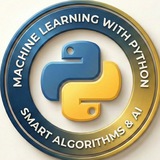Best LLMs Courses
Link: https://www.mltut.com/best-large-language-models-courses/
#MachineLearning #DeepLearning #BigData #Datascience #ML #HealthTech #DataVisualization #ArtificialInteligence #SoftwareEngineering #GenAI #deeplearning #ChatGPT #OpenAI #python #AI #keras #SQL #Statistics #LLMs #AIagents
http://t.me/codeprogrammer⭐️
Link: https://www.mltut.com/best-large-language-models-courses/
#MachineLearning #DeepLearning #BigData #Datascience #ML #HealthTech #DataVisualization #ArtificialInteligence #SoftwareEngineering #GenAI #deeplearning #ChatGPT #OpenAI #python #AI #keras #SQL #Statistics #LLMs #AIagents
http://t.me/codeprogrammer
Please open Telegram to view this post
VIEW IN TELEGRAM
👍7❤1
👨🏻💻 The first time I used Pandas, I was supposed to quickly clean and organize a raw and complex dataset with the help of Pandas functions. Using the groupby function, I was able to categorize the data and get in-depth analysis of customer behavior. Best of all, it was when I used loc and iloc that I could easily filter the data.
┌
└
#MachineLearning #DeepLearning #BigData #Datascience #ML #Pandas #DataVisualization #ArtificialInteligence #SoftwareEngineering #GenAI #deeplearning #ChatGPT #OpenAI #python #AI #keras #SQL #Statistics #LLMs #AIagents
http://t.me/codeprogrammer
Please open Telegram to view this post
VIEW IN TELEGRAM
👍26❤2
Regression & Classification Loss Functions
#MachineLearning #DeepLearning #BigData #Datascience #ML #Pandas #DataVisualization #ArtificialInteligence #SoftwareEngineering #GenAI #deeplearning #ChatGPT #OpenAI #python #AI #keras #SQL #Statistics #LLMs #AIagents
http://t.me/codeprogrammer⭐️
#MachineLearning #DeepLearning #BigData #Datascience #ML #Pandas #DataVisualization #ArtificialInteligence #SoftwareEngineering #GenAI #deeplearning #ChatGPT #OpenAI #python #AI #keras #SQL #Statistics #LLMs #AIagents
http://t.me/codeprogrammer
Please open Telegram to view this post
VIEW IN TELEGRAM
👍8❤4
Python Network Programming Cheat Sheet 🖥
#MachineLearning #DeepLearning #BigData #Datascience #ML #Pandas #DataVisualization #ArtificialInteligence #SoftwareEngineering #GenAI #deeplearning #ChatGPT #OpenAI #python #AI #keras #SQL #Statistics #LLMs #AIagents
http://t.me/codeprogrammer✅
#MachineLearning #DeepLearning #BigData #Datascience #ML #Pandas #DataVisualization #ArtificialInteligence #SoftwareEngineering #GenAI #deeplearning #ChatGPT #OpenAI #python #AI #keras #SQL #Statistics #LLMs #AIagents
http://t.me/codeprogrammer
Please open Telegram to view this post
VIEW IN TELEGRAM
👍9
The Big Book of Large Language Models by Damien Benveniste
✅ Chapters:
1⃣ Introduction
🔢 Language Models Before Transformers
🔢 Attention Is All You Need: The Original Transformer Architecture
🔢 A More Modern Approach To The Transformer Architecture
🔢 Multi-modal Large Language Models
🔢 Transformers Beyond Language Models
🔢 Non-Transformer Language Models
🔢 How LLMs Generate Text
🔢 From Words To Tokens
1⃣ 0⃣ Training LLMs to Follow Instructions
1⃣ 1⃣ Scaling Model Training
1⃣ 🔢 Fine-Tuning LLMs
1⃣ 🔢 Deploying LLMs
Read it: https://book.theaiedge.io/
Read it: https://book.theaiedge.io/
#ArtificialIntelligence #AI #MachineLearning #LargeLanguageModels #LLMs #DeepLearning #NLP #NaturalLanguageProcessing #AIResearch #TechBooks #AIApplications #DataScience #FutureOfAI #AIEducation #LearnAI #TechInnovation #AIethics #GPT #BERT #T5 #AIBook #AIEnthusiast
https://t.me/CodeProgrammer
Please open Telegram to view this post
VIEW IN TELEGRAM
👍17❤5👎1
👨🏻💻 If you want to become a data science professional, follow this path! I've prepared a complete roadmap with the best free resources where you can learn the essential skills in this field.
#ArtificialIntelligence #AI #MachineLearning #LargeLanguageModels #LLMs #DeepLearning #NLP #NaturalLanguageProcessing #AIResearch #TechBooks #AIApplications #DataScience #FutureOfAI #AIEducation #LearnAI #TechInnovation #AIethics #GPT #BERT #T5 #AIBook #AIEnthusiast
https://t.me/CodeProgrammer
Please open Telegram to view this post
VIEW IN TELEGRAM
👍35❤18👏1
10 Must-Know Python Libraries for LLMs in 2025
Large language models (LLMs) are changing the way we think about AI. They help with #chatbots, text generation, and search tools, among other natural language processing tasks and beyond. To work with #LLMs, you need the right #Python libraries.
In this article, we explore 10 of the Python libraries every developer should know in 2025.
Read and learn:
https://machinelearningmastery.com/10-must-know-python-libraries-for-llms-in-2025/
https://t.me/CodeProgrammer✅
Large language models (LLMs) are changing the way we think about AI. They help with #chatbots, text generation, and search tools, among other natural language processing tasks and beyond. To work with #LLMs, you need the right #Python libraries.
In this article, we explore 10 of the Python libraries every developer should know in 2025.
Read and learn:
https://machinelearningmastery.com/10-must-know-python-libraries-for-llms-in-2025/
https://t.me/CodeProgrammer
Please open Telegram to view this post
VIEW IN TELEGRAM
👍7🔥2
Anyone trying to deeply understand Large Language Models.
Checkout
by Tong Xiao & Jingbo Zhu. It’s one of the clearest, most comprehensive resource.
⭐️ Paper Link: arxiv.org/pdf/2501.09223
Checkout
Foundations of Large Language Models
by Tong Xiao & Jingbo Zhu. It’s one of the clearest, most comprehensive resource.
#LLMs #LargeLanguageModels #AIResearch #DeepLearning #MachineLearning #AIResources #NLP #AITheory #FoundationModels #AIUnderstanding
✉️ Our Telegram channels: https://t.me/addlist/0f6vfFbEMdAwODBk📱 Our WhatsApp channel: https://whatsapp.com/channel/0029VaC7Weq29753hpcggW2A
Please open Telegram to view this post
VIEW IN TELEGRAM
❤14
Self-attention in LLMs, clearly explained
#SelfAttention #LLMs #Transformers #NLP #DeepLearning #MachineLearning #AIExplained #AttentionMechanism #AIConcepts #AIEducation
✉️ Our Telegram channels: https://t.me/addlist/0f6vfFbEMdAwODBk📱 Our WhatsApp channel: https://whatsapp.com/channel/0029VaC7Weq29753hpcggW2A
Please open Telegram to view this post
VIEW IN TELEGRAM
❤8💯3👨💻1
